BY HENRY SHEEHAN
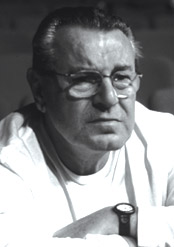 At age 76, Milos Forman has had more than enough accomplishments to feather a retirement. For starters, there’s his crucial role in the rise of the Czech New Wave during the mid-’60s. He was in Paris when Russian tanks crushed the Prague Spring and so he made his way - partly by choice, partly by circumstance - to the U.S.
At age 76, Milos Forman has had more than enough accomplishments to feather a retirement. For starters, there’s his crucial role in the rise of the Czech New Wave during the mid-’60s. He was in Paris when Russian tanks crushed the Prague Spring and so he made his way - partly by choice, partly by circumstance - to the U.S.
It was in 1984, having established nonpareil credentials as an adapter of works from other media with One Flew Over the Cuckoo’s Nest and Hair that Forman transferred Amadeus from stage to screen. Known for his quirks of casting, Forman went for virtual unknowns - Tom Hulce and F. Murray Abraham - in the drama of a flailing Mozart in 18th-century Vienna. The European-bred filmmaker also solidified his reputation as a director who could re-create a period on screen, whether it be 200 or 20 years ago.
Amadeus went on to be a hit critically and commercially and won the DGA’s Directorial Achievement Award and eight Oscars. More than any picture he’d done before, Amadeus revealed Forman’s ability to marshal both Hollywood-style resources and an Old World sensibility (no doubt aided by longtime collaborators cinematographer Miroslav Ondrícek and costume designer Theodor Pistek). Although it is a masterful performance, Forman modestly demurs at the start of our conversation. “Listen, I don’t know very much about the lighting process. I am pretty ignorant about these things.”
In the scene Forman describes, Mozart, who is beginning to deteriorate, is visited by his stern father. Trying to convince him that he is doing well, Mozart takes him to a costume party where the composer for the first time sees the death mask and has a vision of his own demise.
Before this scene is one in which Mozart is humiliated by a rich merchant who is using him to teach his dogs to be silent when they hear music. Now we pan 180 degrees and see the outraged Mozart leave the house. We turn with him and discover that there is a bustling, big city full of life in the market. For that reason, I put the camera on a crane so that when he passes, the camera can go up and see the whole space, the crowd and life in the marketplace. This joyous city swallows Mozart as he walks through watching everything around him.
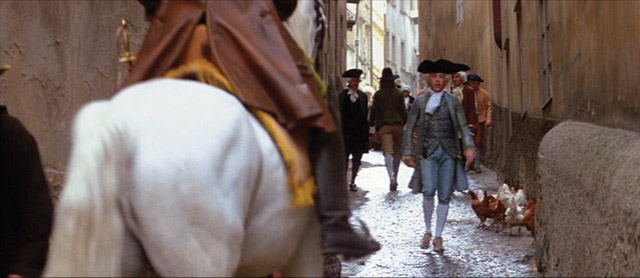
What was important for me here was to see Mozart walking, losing his gloomy mood and enjoying life again. That’s why I used the narrower street, so that when we see Mozart nothing distracts us. When I need to concentrate on one person, I use a longer lens that puts in focus just the distance where the main character is. Use of lenses for me is always dictated by how important it is to concentrate on a certain character’s image or things in the image. The depth of focus with a long lens can really help to streamline an audience’s interest.
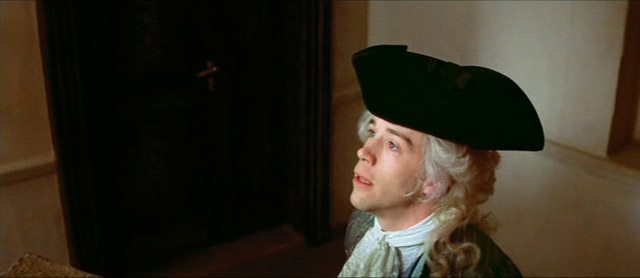
Here, for the first time Mozart encounters the image of death. That’s why I led him to this close-up where we can see very clearly his change of expression. So in the split second before he realizes it’s his father, he’s panicked because it’s like an image of death. I didn’t want any lighting that would make deep shadows or anything like that, to make his face dramatic in any way. It has to be the expression here, the change of expression from a happy face to a panicked face.

I put the father in front of the window, so that he’s backlit, his face is dark and we just see the cape and the hat and the black face. The decision to shoot in widescreen was effectively decided by the look of the period, which is so rich and so lush. But when you need drama you can read on the faces of actors, when you go to the close-up or medium close-up, widescreen is more effective. In both Mozart’s close-up and the father’s, it’s just gray walls in the background. Nothing distracts you so you can get the full impact of the close-up.

I never use storyboards. I always like to come on the set and see the reality around me. Then I rehearse with the actors in the space, which is already finalized by the prop man, set decorator, set designer and costume designer. Only then do I decide how to cover the scene. Here, I wanted to show what the father has to deal with. Now Mozart has got himself in the fun of getting the mask and costumes. But it’s a little sinister. That’s why I put the camera a little lower, so we look from down to up.
If you notice, the black mask is being put on his father’s head, but it’s not from below. It’s absolutely a very normal camera, at a normal height. It’s like a POV of somebody. I didn’t want it to imply that the father is already being a sinister character. He’s not; he’s putting on the mask. That should be as real, as sober, as normal as anything else. You are just renting a mask, okay. So here are the guys from the shop putting the mask on his head, and nothing strange about it.

I first put the chairs in a circle. Then I set the frame so that we see as much as possible. I brought in the people who will play musical chairs, and ask them to play. I adjusted the camera angle, so that we wouldn’t miss any of this motion. Now I filled the rest of the stage with extras. I always like it when my assistant directors work with extras the way I work with the main actors; to explain what they’re doing there. So there is always in the background a little bit of a mess, but that makes it more real.
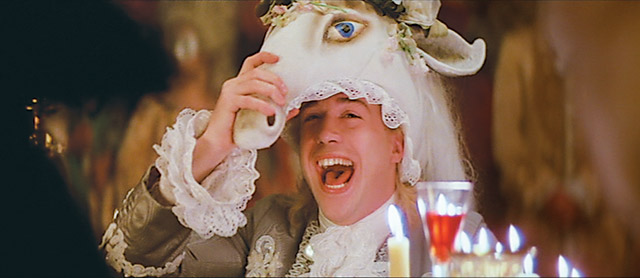
This is probably a 75mm lens. When Mozart’s father first comes to visit him, we see the same kind of glass of wine at Mozart’s piano. It is preparing us for the end, when he is very drunk very often. In this shot it’s like a rosé wine, because if it was a white wine it might look like water. If it’s a deep red wine, it might look like coffee. These masks were created by costume designer Theodor Pistek. He manufactured them individually for each of the characters so that they could breathe, act and behave not as actors but as human beings.
This mask has on one side the stern face; on the other side, which is on the back of the head, is a smiling face. But what I did was that the father has the smiling face in front. So Mozart laughs because he sees the smiling face of the mask. But then the father takes off the mask, under this smiling mask is this very stern and severe and judgmental look of his father. I wanted to have this kind of a contrast there.
So here, in these three images [8-10], the main drama between father and son is taking place. I’m very much thinking about editing during the shooting. I must make sure that I’m giving myself more than one option in editing. So that this could cut very well with this one, but what about if it doesn’t? So then I want to have another angle, or the second camera doing something I could use if it doesn’t work. I am thinking about editing, but I never give myself just one possibility for an edit.

This shot is done exactly the other way from how I did the musical chairs. Here, I first staged the life on the staircase with the extras. Once that looked real and exciting, I asked Salieri to find his way through the crowd. The crowd is fixed and the actor has to avoid bumping into the extras. We are not even sure why we are seeing this shot: you see someone, then he disappears again, and suddenly he’s here in front of you and you know who he is. This is probably a 32mm, a wider lens, which will give you the depth of focus so you can see everything.
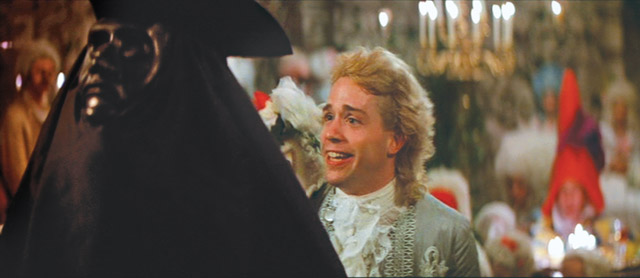
I do a composition so that it pleases my eye. Of course, whatever composition and angle I choose has to serve the story. It was very important for me to see the desperate Mozart’s effort to placate his father. Not to simply read it on his face, but to have this bulk, this blackness of his masked father there, and nothing to distract the audience’s eye from it. Again, it’s with a longer lens and everything in the background is not noticeable. But it is also important the audience feels the background is there, that we are there, that it’s real.
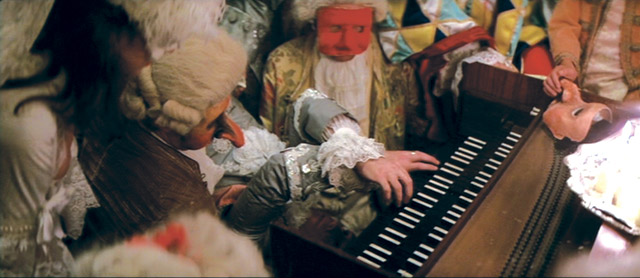
For this kind of shot, where Mozart is playing the piano upside down, you have to be very careful that you know what you want to do, so that you find some stuntmen who are strong enough and skillful enough not to drop him. To get these shots from my point of view was very easy. Itwas incredibly difficult for Tom Hulce to learn. He didn’t know at which moment we will see his hands connected to his face in a long shot, so he had to learn much more. He practiced several hours a day and I was told he didn’t hit one wrong key.
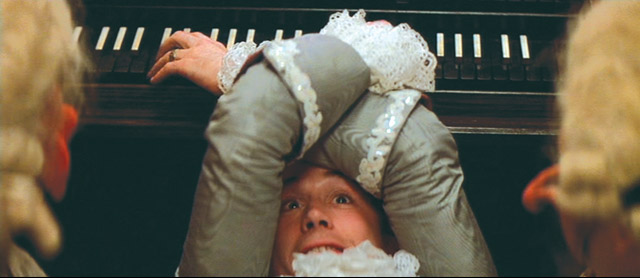
In the first shot [number 13], you can’t see Mozart’s face; it could have been a double. So that’s why I went close-up from the front, so that we could see his face and see his fingers on the piano. I don’t think that anybody who doesn’t play piano can really appreciate how incredibly difficult this is - to play backwards. That’s why I went to the close-up, so we know that he is really doing it, it’s not a double. It was amazing. But then he sees Salieri in his mask, and the scene ends on a dark note.